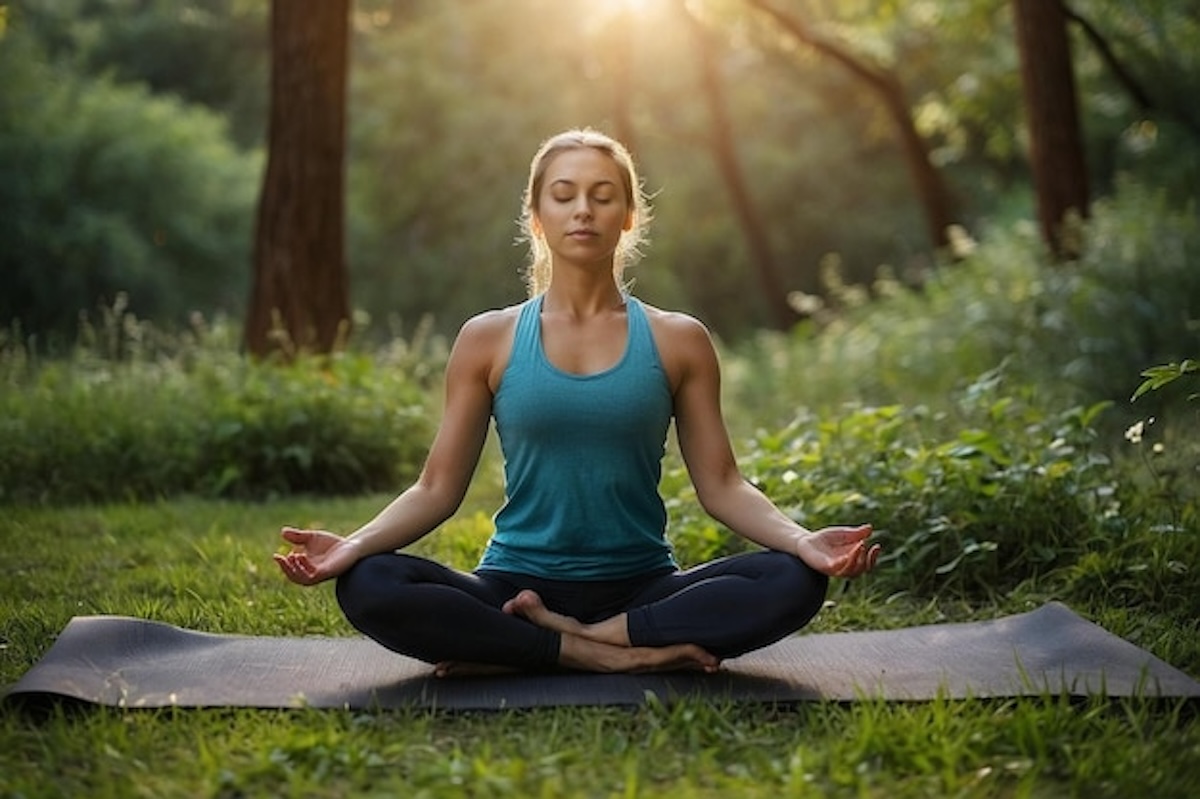Individuals often turn to ancient practices rooted in traditional wisdom in search of holistic well-being. One such practice that has gained attention is the Shunya Mudra. This mudra, or hand gesture, is believed to hold profound benefits for both the body and mind.
In this blog post, we will delve into the intricacies of Shunya Mudra- exploring its origins, benefits, and even its potential side effects. By the end, you’ll have a comprehensive understanding of how incorporating Shunya Mudra into your routine contributes to your overall wellness.
Origin and Symbolism of Shunya Mudra
Shunya Mudra, also known as the “Mudra of Emptiness” or “Heavenly Gesture” originates from the ancient practice of mudras in Ayurveda and yoga. The term “Shunya” translates to “zero” in Sanskrit, symbolizing the “space”.
“Space is what allows matter to move. Ether is what allows life to be lived.”
-Krishnamacharya
The mudra is formed by joining the tip of the middle finger with the base of the thumb while keeping the other fingers extended. This specific arrangement of fingers is believed to activate certain energy channels in the body, facilitating a connection between the individual and the cosmic energies.
How To Do Shunya Mudra?
Seating Position:
- Sit comfortably in a cross-legged position on the floor or in a chair with your spine erect. Maintain a comfortable and relaxed posture, keeping your back straight. (If One is not able to sit down can perform this while sitting on the chair with the spine erect)
Hand Position:
- Bring your hands in front of you and place the palm on your thighs. Keep your palms facing up. Bend the middle finger of each hand and place the fingernail of the middle finger against the soft pad at the base of the thumb.
Other Fingers:
- Allow the other fingers to remain extended but relaxed. The ring finger, index finger, and little finger should be straight.
Connection:
-
Gently press the middle finger’s nail against the thumb’s pad, applying a subtle pressure. The other fingers can remain comfortably extended.
Breathing:
-
Focus on your breath. You can practice Shunya Mudra during meditation or as part of your yoga practice.
Duration:
-
Hold the mudra for at least 15-30 minutes daily, or as long as you feel comfortable. After the desired duration, release the mudra and relax your hands.
Benefits of Shunya Mudra
1. Relief from Ear-related Issues
Shunya Mudra may positively impact ear-related problems. Regular practice helps in treating ear infections, pain, tinnitus, vertigo and hearing loss within the body.1 Here’s an elaboration on how Shunya Mudra is thought to be associated with ear-related concerns:
- Shunya Mudra involves the thumb, which is associated with the element of ether. The stimulation of specific nerve endings through the mudra has a positive impact on ear pain, potentially providing relief.
- Tinnitus refers to hearing sound in the ears without an external source. Shunya Mudra helps to alleviate tinnitus by promoting overall well-being and balance in the body’s energy systems.
- Improves overall ear health, potentially addressing mild hearing issues. Hearing loss can be caused by various factors, including age, genetics, and exposure to loud noises
2. Alleviation of Throat Disorders
It is associated with the throat chakra (Vishuddha). The throat chakra is believed to manage communication, self-expression, and the element of sound. Shunya Mudra is thought to balance the energy associated with this chakra and may have potential benefits for the throat area.
Shunya Mudra can have a positive impact on physical issues related to the throat, such as sore throat or thyroid imbalances. Thus, it also helps in metabolism.
3. Enhanced Concentration and Mental Clarity
Shunya Mudra is thought to stimulate the air element in the body, improving concentration and mental clarity. Practitioners often claim that regular practice helps calm the mind and enhances cognitive functions, making it an excellent tool for those seeking mental focus.
4. Communication
We own the world & crack some good deals by merely communicating well. So communication has become an important part of our lives, isn’t it? Shunya Mudra is thought to help balance the energy in the throat chakra, which is associated with communication. Practitioners believe that the mudra can enhance both verbal and non-verbal communication skills.
5. Self-Expression
Have you ever found difficulty in expressing yourself? Well, this creates a whole chaos if not expressed clearly in the mind and life, isn’t it? Shunya Mudra can help you with expressing yourself correctly. The throat chakra is linked to self-expression, creativity, and the ability to speak one’s truth. Shunya Mudra is believed to stimulate this energy centre, promoting a sense of authenticity and the ability to express oneself openly. This helps you give clarity in mind and improves our relations with loved ones.
6. Stress Reduction and Relaxation
The calming influence of Shunya Mudra extends beyond mental benefits. It is said to have a relaxing effect on the nervous system helping to reduce stress and anxiety. This makes it a potentially beneficial tool in managing the pressures of modern life.
7. Enhanced Self-awareness and Spiritual Connection
Practitioners often describe a heightened sense of self-awareness and a deeper connection to spiritual energies through regular Shunya Mudra practice. This aspect makes it a good choice among those exploring mindfulness, meditation practices and practising spirituality.
8. Improves our balance
Vertigo is characterized by a sensation of dizziness or spinning. The practice of Shunya Mudra is believed by some to have a grounding effect on the body’s energy, potentially contributing to relief from vertigo symptoms.
Shunya Mudra Side Effects and Precautions
While Shunya Mudra is generally considered safe for most individuals, it’s essential to approach any new practice with caution. Some potential side effects and precautions include:
1. Discomfort or Strain
Individuals with arthritis or joint-related issues may experience discomfort or strain while holding the mudra for an extended period. It’s crucial to listen to your body and modify the practice as needed.
2. Avoid during pregnancy
Pregnant women are advised to avoid Shunya Mudra, as some believe it may stimulate specific acupressure points that could potentially trigger contractions.
3. Consultation with a Healthcare Professional
Before incorporating Shunya Mudra or any new practice into your routine, especially if you have pre-existing health conditions, it’s advisable to consult with a healthcare professional and yoga teacher to ensure it aligns with your individual needs.
In conclusion, Shunya Mudra is a captivating and elaborate practice deeply rooted in the ancient traditions of yoga and Ayurveda. As we delved into its essence, it became evident that this hand gesture, associated with the element of ether and the throat chakra (Vishuddha), holds the potential to offer a range of benefits for both physical, mental and spiritual well-being. The primary focus of Shunya Mudra is on balancing the energy in the throat chakra which is linked to communication, self-expression, and the element of sound. Throughout our quest, we discovered that individuals who incorporate Shunya Mudra into their meditation and yoga practices often report improvements in various aspects of communication. The mudra is believed to enhance both verbal and non-verbal expression, fostering a sense of clarity in speech and cultivating a deeper connection with one’s authentic self.
Beyond its effects on communication, the benefits of Shunya Mudra are associated with mental clarity. The mudra can help clear mental fog and improve focus. The mudra involves specific hand positioning and concentrated awareness, which contributes to a calming effect on the mind. This reduces the day-to-day stress.
It’s important to approach Shunya Mudra and similar practices with an open mind, understanding that their effectiveness can vary from person to person. As we conclude our exploration of Shunya Mudra, it is worth emphasizing the significance of individual experiences and the holistic nature of well-being. Combining practices like Shunya Mudra into one’s routine can be a personal journey, fostering a deeper connection with the self and a greater understanding of the subtle energies that shape our presence. As we bid goodbye to the exploration of Shunya Mudra, let us carry with us the essence of its teachings—a reminder that within the stillness of a mudra, we may discover the depths of our innermost selves.


